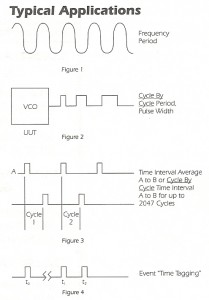53A-541 UNIVERSAL DIGITIZING COUNTER CARD
ORDERING INFORMATION
53A-541 – Universal Digitizing Counter Card
53A-729 – Adapter Cable
OPT XX – User-specified Length in Feet (18 max)
53A-730 – Adapter Cable
OPT XX – User-specified Length in Feet (48 max)
• 10 MHz universal counter/timer and digitizing counter
• Timer/counter functions include: frequency, period, pulse width, time interval, averages, and others
• Digitizing Counter mode allows these same measurements to be made on a cycle-by-cycle basis within a waveform
• Automatically performs time interval relationships between two waveforms
The 53A-541 Universal Digitizing Counter with Time Tag Memory (UDC) provides two input channels (A and B) capable of measuring signals in the subhertz to 10 Megahertz range. The UDC incorporates both a Universal Counter/Timer and a Digitizing Counter into a single instrument. In Timer/Counter mode, all of the functions associated with a traditional Universal Counter are available, including frequency, event count, period, period average, pulse width, pulse width average, time interval, time interval average, duty cycle, and duty cycle average.
In Digitizing Counter mode, the UDC uses its Time Tag Memory to allow the user to analyze the input signal in greater depth by storing the absolute time of each successive transition of the incoming waveform in a 28-bit by 2048 word memory.
Storing absolute transition times allows the user to analyze the time interval relationships between two waveforms, or frequency, period, pulse width, and duty cycle of individual waveforms on a cycle-by-cycle basis. One practical application of these features is the ability to automatically generate timing diagrams.
The various analyses may either be performed in real time as the signal is being acquired (and the results read out “on-the-fly”), or the waveform transition data may be stored for later post-processing or both.
The length of the UDC measurement cycle (gate duration) can be controlled using a programmable time interval by specifying the number of A or B channel events, by means of direct program control or through an external gate.
Trigger level, automatic trigger level, search, slope, attenuation. and input control for both channels are fully programmable. If the automatic search option is used, the level that is set may be read by the system controller. Either channel may be disabled under program control or A may be commoned to B to apply the same signal to both channels.
BITE
Built-In-Test Equipment (“BITE”) for the UDC is provided by a series of LEDs that provide a visual indication of a triggered channel. as well as information on gate status and programming errors.
Specifications
Number of Channels:
Two.
Functions (Counter/Timer Mode):
Frequency, Period. Pulse Width, Time interval (A to B or B to A), Event Count Duty Cycle. Period Average,
Pulse Width Average, Time interval Average, Duty Cycle Average.
Function (Digitizing Counter Mode):
Frequency, Period, Pulse Width, Time interval. Event Count Duty Cycle.
Input Characteristics:
Frequency Range, 0 to 10 MHz.
Dynamic Range:
1 MOhm, X1, 100 mV to 7V RMS.
X3, 300 mV to 21V RMS.
50 Ohms, X1. 100 mV to SV RMS.
X3, 300 mV to 7V RMS.
Input Slope, positive or negative (program selectable).
Input Impedance, 1 MOhm. 30 pF. or 50 Ohms (program selectable).
Input Coupling, DC or AC (program selectable).
Attenuator. X1 or X3 (program selectable).
Channel Input separate or common A to B (program selectable).
Input Protection:
1 MOhm, X1, ± 125V dc or V RMS, 0 to 100 Hz. 20V RMS, 100 Hz to 20 KHz 7V RMS. 20 KHz to 10 MHz.
X3, ±125V dc or V RMS, 0 to 100 Hz. 60V RMS, 100 Hz to 20 KHz. 21V RMS, 20 KHz to 10 MHz. 50 Ohms,
7V RMS.
Trigger Level Range:
X1 ±2.56V dc, .02V dc programming resolution.
X3 ±7.68V dc, .06V dc programming resolution.
Trigger Accuracy:
X1, ±30 mV
X3, ±90 mV
Gate Time:
Range, 1 µsec to 427 seconds, 2 to 4 x 10^9 events of input A or B. programmable start/stop, or external TTL control.
Resolution. 100 microsecond or 1 event count.
Accuracy, ±(Time Base Stability x Gate Time) ±100 nsec.
Time Base:
Frequency, 20 MHz.
Accuracy. settable to ±0.01 ppm.
Aging Rate, < 1 x 10^7 per month,
1 ppm/year maximum @ 25°C.
Stability, <4 x 10^-6, 0 to 50°C
•Gate Error = ±([Time Base Stability x Gate Time) ±100 nsec ± Gate/Event Uncertainty.
Data Returned as (Programmable) :
Floating point decimal with exponent (ASCII String). Binary (32-bit ANSI floating point), Blocked Binary.
Programmed By:
ASCII Characters.
Cable Supplied:
53A-729 (2 each) .
Additional cables may be required, please see Card to Cable matrix.
Timer/Counter Mode
Frequency:
Range. 0.003 Hz to 10 MHz.
Accuracy, ±((Frequency Measured) – ((Frequency Measured)(Gate Time)/ Gate Time+ Gate Error*))) Hz.
Period:
Range, 0 to 25 sec.
Resolution, 100 nsec.
Accuracy, ±Gate Error*
Pulse Width:
Range, 100 nsec to 25 sec.
Resolution, 100 nsec.
Accuracy. ±Gate Error*.
Time lnterval A to B. B to A:
Range, 0 nsec to 25 sec.
Resolution. 100 nsec.
Accuracy. ±Gate Error* .
Event Count:
Range, 0 to 4 x 10^9.
Resolution. 1 Count.
Duty Cycle:
Range, 0 to 100%.
Period Range, 200 nsec to 25 sec.
Accuracy. ((Pulse Width/Period)±((Pulse Width + Gate Error*)/Period-Gate Error*))) 100%.
Time Average Functions (Interval, Period. Pulse Width. Duty Cycle):
Number of Occurrences in Average. 1 to 1023 .
Averaging Time. 200 nsec to 25 sec.
Accuracy, ((±Gate Error*)/(No. of Occurrences x Average Period))%.
Digitizing Counter Mode
Time Range: 0 to 25 sec.
Time Tag Resolution: 100 nscc.
Time Tag Accuracy: ±Gate Error*.
Number of Events Individually Time Identified:
2047 time intervals which contain either a positive or negative slope transition of Channel A or a positive or negative slope transition of Channel B. or a coincident occurrence of any of the above.
•Gate Error= +(Time Base Stability x Gate Time) + 100 nscc.
